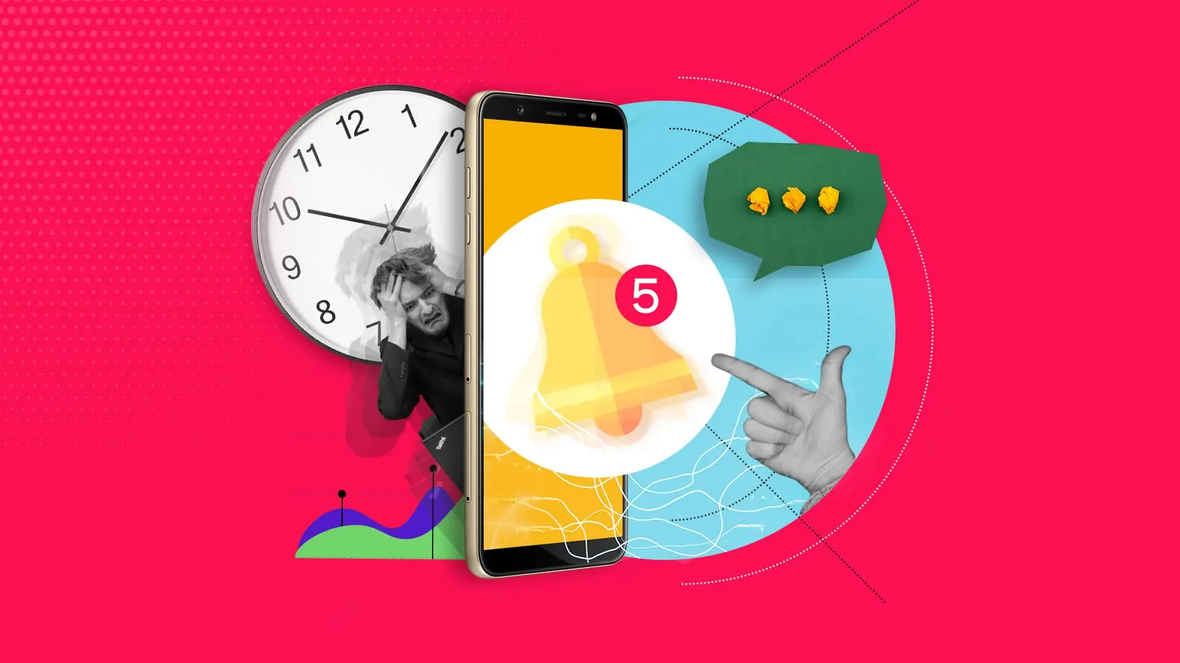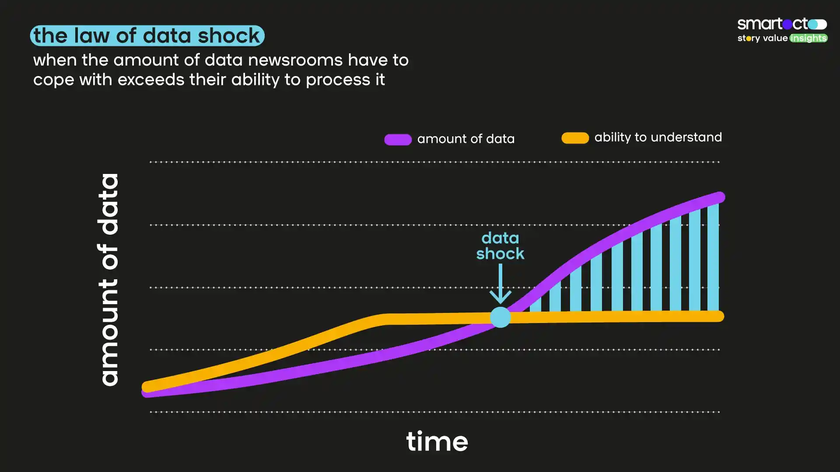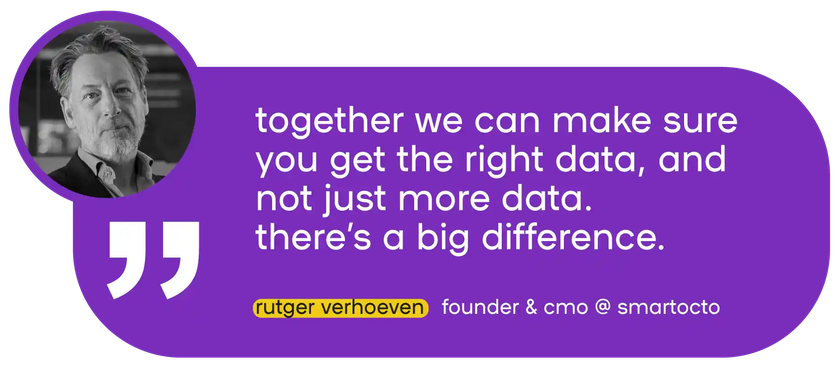If you’ve been in the business of creating and producing content for a while, you’re probably familiar with the term ‘Content Shock’. For those needing a recap, it’s the theory Mark Schaefer presented in the early 2000s that simply states that there’s just not enough time in a day to consume all the content that’s thrown at us on all possible channels. Because of this, people are forced to make choices and decide - on whatever grounds they deem appropriate - whether to stay connected to people, brands, channels or not. And once they decide to unfollow you and lose interest in you, it’s hard (and also very unlikely) to get their attention back.
Smart notifications: the simple, single answer to Data Shock
June 10, 2020 by Rutger Verhoeven

Now, clearly we’re hoping you’ll read the whole article (you should! It’s great!), but if you’re in need of a brief summary, here’s what you absolutely need to know:
- The daily production and volume of content in the digital domain is so high that people are not able to read and consume everything: this is called content shock
- As a result they make decisions on who to follow based on interest and relevance
- Most newsrooms, editorial rooms and content marketing companies turn to data to get grip on the complexities of the digital domain
- But! Because there are so many tools in the market that serve you more data, graphs, figures and charts lots of editors and storytellers are confused: where readers experience content shock, editors get data shock
- The solution to this all is actionable insights and smart notifications. And, as luck would have it, at smartocto we happen to serve that, with pleasure!
We’re not surprised that people cull their notifications. Considering that the amount of channels just keeps on increasing and with it the amount of content, it’s not weird at all. We get it.
Here’s a test for you: just check your own phone for, let’s say, news brands and see who is still allowed to send you a push notification and who’s not. Or even worse, who’s left the ‘frontpage’ or gone to never-neverland all together. You’re selective, right? And it’s not just you: everybody is making these choices, and you know how people make the cut? It’s always based on the relevance of the storytelling.
If you don’t feel a connection to what’s being delivered to your digital inbox, or if those notifications are a bit too frequent, you have the power to decide to mute these brands and never hear from them again - and it’s a power we happily wield. Of course for these brands (and your brand!) this is a very unpleasant reality. Power to the people has turned into power to the button. Power of the moment.
Actionable data is what you need
Because of content shock and the rather unpredictable power of the moment, brands, publishers and content marketing companies need to try and get more of a grip on their storytelling efforts. The relevance needs to be spot on - all of the time. And so questions like: When is my story relevant? On which channels can I reach my target group best? What is the best time to publish news or longreads? When should I consider an update on an article? Is it smart to wait for a social post until the next morning since it’s already after 10pm? On which device is my audience reaching out to me during the day?
Yes, it’s complex, and if it sounds like all you’re actually going to be reaching for is a packet of aspirin, there’s also good news. All these questions can be answered with data - but of course it needs to be the right data. At smartocto we know you need actionable data - because without a concrete tip, data doesn’t mean anything.
So let’s get into that.
Without a concrete tip, data doesn’t mean anything
Because data has become important to newsrooms, editorial rooms, and is an integral part of storytelling, the amount of data has increased - and with it the number of dashboards and data collecting tools on the market. It’s sometimes a total jungle out there. Some of these tools and dashboards are really fancy and most of them show (lots of) numbers, charts, figures and options that don’t necessarily tell you what it all means. There’s the sense that the fact this information is there means we should be using it because it kind of looks important, right? The reality is that in almost every case these projected numbers, charts, and graphs don’t tell you what you should do with them.
Exhausting and deadly
Paradoxically, with the effort to get a grip on the digital footprint, most editorial rooms are not only trying to deal with the impact of the content shock, they also have to figure out a way to get through the big ol’ plate of data spaghetti presented to them. It’s almost like we stepped up to the next level of digital revolution. It’s because of this that I think most digital storytellers are in Data Shock. It’s like a structural heart attack: exhausting and deadly in the end.

And thus the question shouldn’t be, ‘how do I get more data into my editorial room?’
It’s not that you are getting closer to the truth if you have access to more data. Or more simply put: more data doesn’t tell you more accurately what to do, how to act and how to make a real connection with your desired audience. It’s just more data.
More data doesn’t tell you more accurately what to do
I feel that big data should work for you and not the other way around. It’s necessary to know what to ask the data: questions that will reveal answers that are useful for your business, that help to reach your targets, and that are actionable to your KPIs. In this manner you filter on relevance and search with focus and knowledge, all within the enormous amount of available data. You don’t need to understand binary code to open a Google Doc. You shouldn’t have to sift through pages of raw data to get the insights you need, and then decide which you can take action on. Why make it harder for yourself? You’ve got better things to do, like telling stories that really connect to your desired audience.
Tip box
To decide if the data in your newsrooms is of relevance, ask yourself some questions.
For example: do I know what to do based on this data? Is the data telling me what I need to know? Is there a difference between data that tells me something from the past (historical data), and data that tells me what to do now? Is the data somehow connected to my business model?
But also try to define what success looks like. Is it based on pageviews? Or on engagement, or even attention time? Do you think reach on LinkedIn is more valuable than reach on Facebook? Are there signature stories that are close to your brand DNA that should be monitored differently than other stories? And, is the data that you collect in line with these outcomes?
That’s the crux of it and at smartocto we take lots of time to understand the way you define success. Together we can set the right search terms and questions and make sure you get the right data and not just more data. There’s a big difference.

Less is more
The solution is less data, more focus on your specific business KPIs, and smart notifications. These are things you need in order to help you get better at storytelling and get more from all the single stories you tell.
Most dashboards and data-collecting tools present data and not solutions or directions. This is one of the reasons why many analytics approaches fail.
And it's the exact reason why we decided to build smartocto, the most actionable editorial analytics system in the world. The power is its simplicity. It’s built and designed with the input of some of the largest newsrooms in the world. It’s based on (and developed with) the knowledge of the founders who have all worked for large media companies trying to deal with the quest for relevance in the digital domain. I believe it’s safe to say that it’s the first tool in the world that recognises that maybe 90% of all editorial rooms are in Data Shock.
Probably 90% of editorial rooms are in Data Shock
So if you also have this unpleasant feeling in the chest, if you fear you might go into Data Shock yourself, or if you’re about to start with the Great Digital Transformation (or maybe you’re already caught right in the middle of it) … Something needs to be done. You need the right data, the right insights and a system that understands and talks to you: a virtual colleague.
Smart Notifications make the difference
At smartocto we believe we can help newsrooms and (online) storytellers to collect the right data for them and translate it into a focused and actionable tip. With this, you’re able to see what action you can take to drive your impact on every single story you publish. With years of experience, with the input of multiple large newsrooms, with the analytics of over a billion stories and the knowledge and dynamics behind multiple business cases, when we say we know how to calculate the best scenario for all of your stories, it’s not just a neat marketing phrase. We know our onions. We translate these scenarios into concrete tips and send them to any mailbox you like. Super convenient, powerful and simple. We believe it’s the answer to the data shock you might be in.
Tip box
It’s always a good thing to sit down with your colleagues and discuss which data insights you would like to have during the day. Which information is of value to you and when? Do you want to know about every story when the reach has passed 1 000 pageviews or do you want to know instantly if someone is reacting to your story on Facebook? Or, if the subscriptions to your newsletter are going haywire after a blogpost on social, would you appreciate a heads up? How often do you want to get these kinds of insights and if you did have an overview of all the published stories, what would it need to consist of?
This will not only help you get a clearer view of what you want from data, but it also gives you the opportunity to start a conversation with the data-skeptics walking around in your newsroom. By the way, did you know we organised a webinar on how to handle them?
You’ll probably notice that lots of the insights you would like to have to drive your online impact are not available within the tools and systems that you work with. Or that it’s all so fuzzy that you just can’t bring yourself to dive into that soggy data-pit of misery. We understand that, and it’s our mission at smartocto to help you to get data-informed so you’re able to make a real online connection.
Maybe you can hire ...
It reminds me of the A-Team’s intro-leader:
If you have a problem …
If no one else can help…
and if you can find them…
maybe you can hire…
The A-Team
In this particular case I suggest you replace the A-team with smartocto and start to make every story count as of today! Oh, and another good thing; unlike B.A. & co, you know where to find us.
For more interesting blogs subscribe to our newsletter. Thanks in advance.
you may also like...
Coronavirus & audience behaviour: 5 actionable insights
During the first months of the pandemic, audience behaviour changed drastically. There's a lot to be learned from this, and we'll share our insights here. A hint: churning out one corona article after the other is not the way to go.

The added value of smart notifications
We're always talking about how smartocto is an actionable editorial analytics tool, but what does this mean? It's all about the smart notifications, explained right here!
